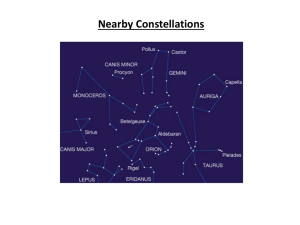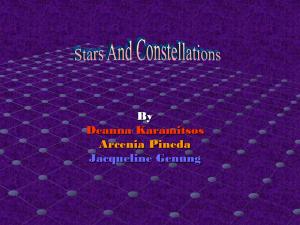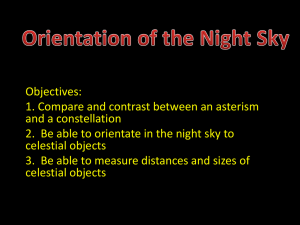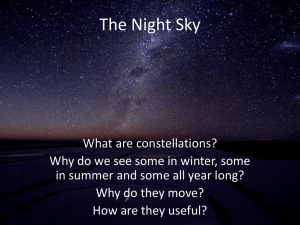The Cosmos - teachiuliamanicea
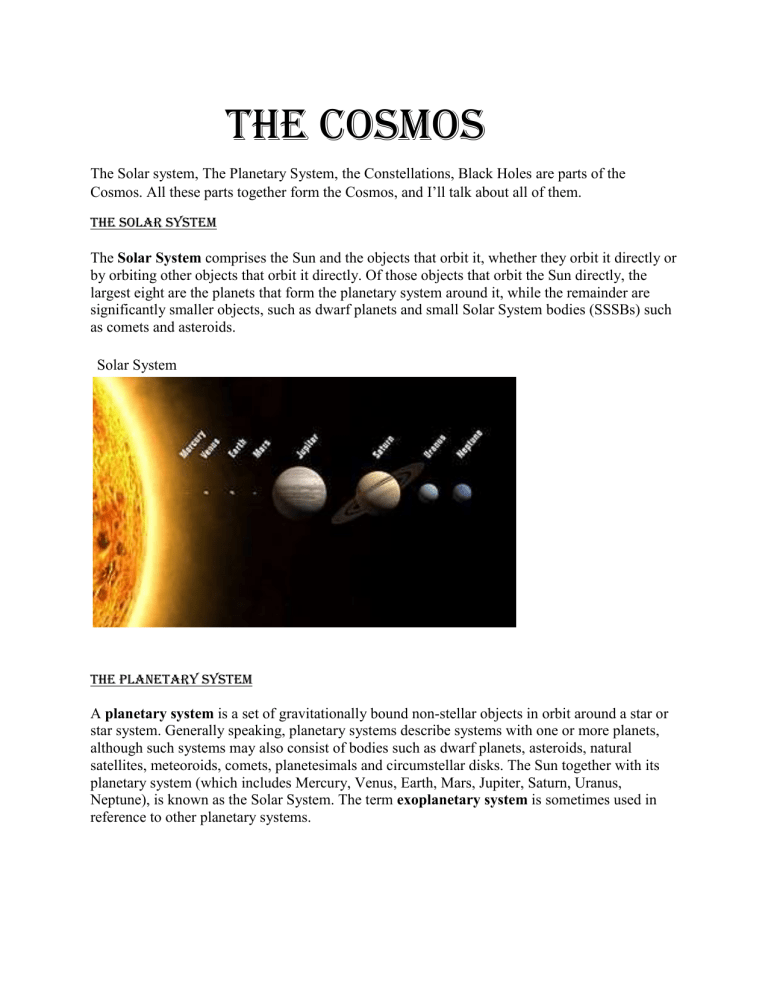
The Cosmos
The Solar system, The Planetary System, the Constellations, Black Holes are parts of the
Cosmos. All these parts together form the Cosmos, and I’ll talk about all of them.
The solar system
The Solar System comprises the Sun and the objects that orbit it, whether they orbit it directly or by orbiting other objects that orbit it directly. Of those objects that orbit the Sun directly, the largest eight are the planets that form the planetary system around it, while the remainder are significantly smaller objects, such as dwarf planets and small Solar System bodies (SSSBs) such as comets and asteroids.
Solar System
The planetary system
A planetary system is a set of gravitationally bound non-stellar objects in orbit around a star or star system. Generally speaking, planetary systems describe systems with one or more planets, although such systems may also consist of bodies such as dwarf planets, asteroids, natural satellites, meteoroids, comets, planetesimals and circumstellar disks. The Sun together with its planetary system (which includes Mercury, Venus, Earth, Mars, Jupiter, Saturn, Uranus,
Neptune), is known as the Solar System. The term exoplanetary system is sometimes used in reference to other planetary systems.
The constellations
In modern astronomy, a constellation is a specific area of the celestial sphere as defined by the
International Astronomical Union (IAU). These areas had their origins in star patterns from which the constellations take their names. There are 88 officially recognized constellations, covering the entire sky. When astronomers say an object is "in" a given constellation, they mean it is within the boundaries of one of these defined areas of sky.
Other cultures also have, or had, their own constellations, such as Chinese, Hindu and Australian
Aboriginal. The names of these constellations are not recognized by the IAU.
The Late Latin term constellātiō
can be translated as "set of stars". The term was first used in astrology, of asterisms that supposedly exerted influence, attested in Ammianus (4th century). In
English the term was used from the 14th century, also in astrology, of conjunctions of planets.
The modern astronomical sense of "area of the celestial sphere around a specific asterism" dates to the mid-16th century.
Colloquial usage does not distinguish the senses of "asterism" and "area surrounding an asterism". The modern system of constellations used in astronomy focuses primarily on constellations as grid-like segments of the celestial sphere rather than as patterns, while the term for a star-pattern is asterism. For example, the asterism known as the Big Dipper corresponds to the seven brightest stars of the larger IAU constellation of Ursa Major.
The term circumpolar constellation is used for any constellation that, from particular latitude on
Earth, never sets below the horizon. From the North Pole, all constellations north of the celestial
equator are circumpolar constellations. In the northern latitudes, the informal term equatorial constellation has sometimes been used for constellations that lie to the south of the circumpolar constellations. Depending on the definition, equatorial constellations can include those that lie entirely between declinations 45° north and 45° south, or those that pass overhead between the tropics of Cancer and Capricorn. They generally include all constellations that intersect the celestial equator.
Since stars travel on their own orbits through their galaxy, constellations change slowly and can even disappear. This takes tens of thousands of years.
Black holes
A black hole is a mathematically defined region of spacetime exhibiting such a strong gravitational pull that no imminent particle or electromagnetic radiation can escape from it.
[1]
The theory of general relativity predicts that a sufficiently compact mass will deform spacetime to form a black hole.
[2]
The boundary of the region from which no escape is possible is called the event horizon. Although crossing the event horizon has enormous effect on the fate of the object crossing it, it appears to have no locally detectable features. In many ways a black hole acts like an ideal black body, as it reflects no light.
[3][4]
Moreover, quantum field theory in curved spacetime predicts that event horizons emit Hawking radiation, with the same spectrum as a black body of a temperature inversely proportional to its mass. This temperature is on the order of billionths of a kelvin for black holes of stellar mass, making it essentially impossible to observe.
Objects whose gravitational fields are too strong for light to escape were first considered in the
18th century by John Michell and Pierre-Simon Laplace. The first modern solution of general
relativity that would characterize a black hole was found by Karl Schwarzschild in 1916, although its interpretation as a region of space from which nothing can escape was first published by David Finkelstein in 1958. Long considered a mathematical curiosity, it was during the 1960s that theoretical work showed black holes were a generic prediction of general relativity. The discovery of neutron stars sparked interest in gravitationally collapsed compact objects as a possible astrophysical reality.
Black holes of stellar mass are expected to form when very massive stars collapse at the end of their life cycle. After a black hole has formed, it can continue to grow by absorbing mass from its surroundings. By absorbing other stars and merging with other black holes, supermassive black holes of millions of solar masses ( M ☉ ) may form. There is general consensus that supermassive black holes exist in the centers of most galaxies.
Despite its invisible interior, the presence of a black hole can be inferred through its interaction with other matter and with electromagnetic radiation such as light. Matter falling onto a black hole can form an accretion disk heated by friction, forming some of the brightest objects in the universe. If there are other stars orbiting a black hole, their orbit can be used to determine its mass and location. Such observations can be used to exclude possible alternatives (such as neutron stars). In this way, astronomers have identified numerous stellar black hole candidates in binary systems, and established that the core of the Milky Way contains a supermassive black hole of about 4.3 million M ☉ .
Source: http://en.wikipedia.org/wiki/Solar_System (10.01.2015, 09:30)
Source: http://en.wikipedia.org/wiki/Planetary_system (10.01.2105, 11:00)
Source: http://en.wikipedia.org/wiki/Constellation (11.01.2015, 08:42)
Source: http://en.wikipedia.org/wiki/Black_hole (11.01.2015, 09:30)
